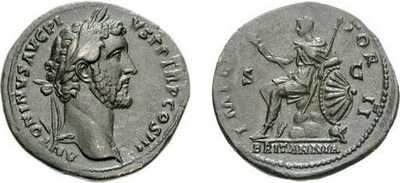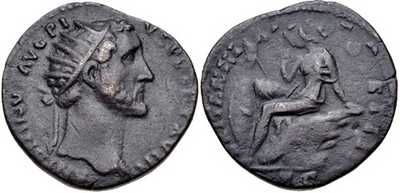| Back to Hadrian | This page is part of the article Roman Coins About Britain | Forward to Commodus |
Hadrian’s adopted son and successor, Antoninus Pius, shared his father’s passions for building walls and minting bronze coins about Britain, so we only have to wait around six years for our next set of coins featuring Britain.
Coins from 140 to 144 AD: Victory Types
The first of his coins, consisting of a sestertius and an as, were minted between 143 and 144 AD, and celebrate conquests in Scotland by the governor Quintus Lollius Urbicus. Antoninus became Imperator for the second time because of this victory.
The sestertius (RIC 3 719) show the winged goddess Victory standing on a globe, facing left, holding a wreath and a palm. The legend is “IMPERATOR II” around the coin with “BRITAN SC” in the field.
Photo Copyright Numismatica Ars Classica NAC AG Auction 64 lot 1184. Sold for 9,500 CHF + fees
The as (RIC 3 732) is similar to the sestertii, but the globe has gone and Victory is now holding a shield that says “Britan”.
Photo Copyright Roma Numismatics Ltd. E-Sale 32 Lot 870. Sold for £650 + fees
This is identical to the sestertius, including the “S C” in the fields. “S C” means “Senatus Consulto” which was only used on bronze coins. Briefly, gold and silver coins were worth the value of the metal they were made from (so you could melt them down and they’d still be worth the same), but the bronze coins were worth more than the value of the metal they were made from, so their value had to be backed by a decree from the Senate. This is basically how our money works now.
Anyway, it looks like Cohen made a mistake when he catalogued this coin, dropping the “S C” from the legend and recording the coin as gold (you can see from the photo of RIC 3 719 above that the sestertius could be mistaken for gold), and these mistakes were missed when RIC 3 was written.
There are a large number of other coins from this timeframe that have Victory on them, and they are sometimes sold as British Victory issues as well. I’m not treating them as related to Britain, but if you are interested in these, you can see them all here.
Coins from 140 to 144 AD: Britannia Types
The second group of coins from 140-144 AD (but mainly 143-144 AD) all feature Britannia on the reverse, and although also said to celebrate the same conquests in Scotland by the governor Quintus Lollius Urbicus, it’s possible that they were minted for a slightly different reason. Like we saw with Hadrian’s coins, Britannia is armed with a spear and unbound, which she wouldn’t be on a standard “capta” coin. Rather than victory over the Britons, these might be celebrating peace and stability in the province again.
An alternative theory (see “Imaging the Golden Age: the coinage of Antoninus Pius” by Clare Rowan) is that they are just part of a generic provincial series, following on from the series Hadrian had minted just a few years before. Starting in 139 AD, Antoninus minted coins carrying the images of Africa, Alexandria, Asia, Cappadocia, Dacia, Hispania, Italia, Mauretania, Parthia, Phoenicia, Scythia, Sicilia, and Thracia, with a second batch starting in 140 AD consisting of Britainnia, Italia and Mauretania.
Regardless of the reason for minting these coins, they are all sestertius, and come with four variants of Britannia.
RIC 3 742 is the earliest of the coins as it doesn’t have Imperator on the reverse, which means it dates to 140-143AD:
RIC 3 745 has a very similar reverse, but with Imperator II added, and the word “Brtitannia” moved to the exergue:
RIC 3 744, with Britannia sitting on a globe with waves below is thought to be unique, with the only example in the British Museum.
If RIC 3 743, with Britannia sitting with her foot on a rock, isn’t unique, then it’s at least exceptionally rare. I’ve only been able to find one photo of it, but as I haven’t been able to secure permission to use it, here’s a line drawing from Cohen’s “Description Historique des Monnaies Frappées Sous L'Empire Romain” instead.
Coins from 154 to 155 AD: Britannia Types
In 154-155 AD, just when the Antonine wall was completed, Antoninus minted two new coins with Britannia on them; a Dupondius (with a radiate portrait) and an As (with a laureate portrait). These were struck in a copper alloy, are only found in Britain, and are generally of poor quality. It’s thought they were minted at a temporary mint in Britain using dies made in Rome.
The reason given for these coins being minted is that they celebrated the suppression of an uprising from the Brigantes tribe, but like the early Britannia coins from Hadrian, there are several issues with this theory which means it’s unlikely to be correct.
Firstly, Britannia is armed with a spear and unbound, which she wouldn’t be on a standard “capta” coin. Conquered natives on “capta” coins are bound and unarmed.
Secondly, these coins are almost exclusively found in Britain, suggesting they were minted for the British market. It’s unheard of for the Romans to celebrate a victory only in the province where it occurred.
Thirdly, and this is the big one, there is no archaeological evidence to support an uprising by the Brigantes at this time. The “Brigantian Revolt” theory was proposed by Francis Haverfield in 1904 based on several pieces of evidence, including the coins themselves and a reference by Pausanias (110-180 AD) that said “He [Antonius] deprived the Brigantes in Britain of a great portion of their land, because with arms they had begun to overrun the Genunian district, which is a tributary to the Romans”. The Brigantes in Britain didn’t have Genunian neighbours. The Brigantes in Raetia did, suggesting Pausanias, or a subsequent scribe, made a mistake and conflated the different Brigantes tribes (see “Hadrian’s Wall: Everyday Life on a Roman Frontier” by Patricia Southern).
Despite the fact that this theory has long been discredited, it is still commonly given as the reason for minting these coins.
Photo Copyright Classical Numismatic Group, LLC. Auction 367 lot 504. Sold for $380 + fees
Photo Copyright Classical Numismatic Group, LLC. Triton XIV Lot 726. Sold for $950 +fees
Article Navigation
| Back to Hadrian | Up to Roman Coins About Britain | Forward to Commodus |









